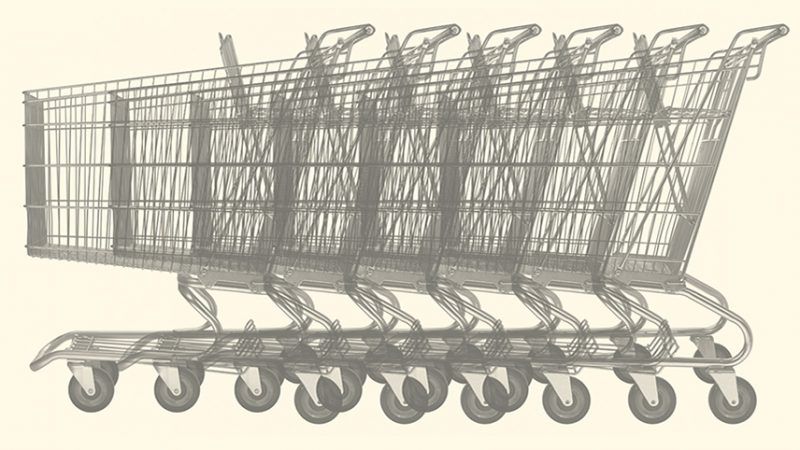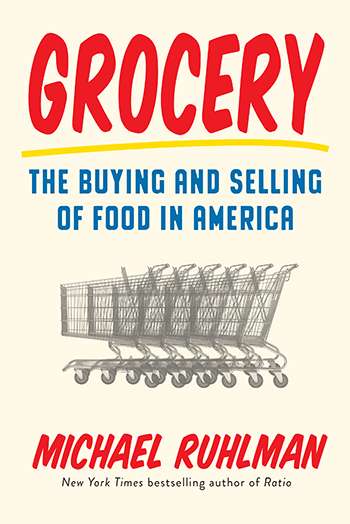How Grocery Stores Got Good
The Amazon/Whole Foods deal is just the latest chapter in a long story of progress.

Grocery: The Buying and Selling of Food in America, by Michael Ruhlman, Abrams Press, 307 pages, $28

Of all the stories in the busy news cycle of 2017, the one with the most meaningful long-run effects may be Amazon's purchase of Whole Foods. What this marriage means for the future of the food industry remains to be seen, but the combination of Amazon's reach and delivery skills with Whole Foods' high-quality products opens many possibilities.
In Grocery, his look at the central role the grocery store has played in American life, food writer Michael Ruhlman more or less predicted the coming together of Amazon and Whole Foods. In 1988, he notes, Walmart opened its first Supercenter, enabling it to extend its skill in distribution and cost cutting to the grocery business. That same year, Whole Foods opened its first store outside of Texas, starting the process of becoming a national chain and establishing a new sort of shopping experience. "The next sea change in food retailing," Ruhlman wrote, prior to the purchase being announced, "may come from another master of distribution, Amazon."
Ruhlman made his name writing about great chefs and cooking, but here he takes on the social and economic changes in the grocery business over the last century. He does so through a study of Heinen's, a mid-sized regional chain based in his hometown of Cleveland. Ruhlman uses the company's history and practices as a window on the role the grocery store has played in American culture.
As recently as the 1970s, grocery stores tended to be smaller, had far less variety and quality of food, and weren't always as clean as they are now. Such changes are among the most powerful evidence we have that nearly all Americans today surpass the living standards enjoyed by even very wealthy people a generation or two ago.
Growing up in an upper-middle-class Detroit suburb in the '70s, I knew nothing of avocados, kiwi fruit, or basmati rice. The closest a grocery store had to a "ready to eat" dinner was some frozen pizza that barely deserved the name, not the variety of hot, fresh food-to-go found at a typical supermarket today. When we consider what's now available at food palaces like Whole Foods or Fresh Market, or even just at Kroger, their 1970s counterparts seem closer to the Soviet experience than the modern American one.
This is part of a longer trend. At the dawn of the 20th century, Ruhlman notes, the average grocery store carried about 200 products. By 1975, it had about 9,000. The number now approaches 50,000. The grocery store of my youth had 5 or 10 chip options; today, chips command an entire aisle. Walk past the dairy cases and consider the varieties of milk, cheese, and eggs, then ask someone in his 50s what his dairy options used to look like. And these new choices are available and affordable even to relatively poor Americans. Food takes up a substantially smaller portion of the average family's budget than it did in the past.
The changes don't stop there. At the turn of the 20th century, most people purchased their food from a specialty store. You got your meat from the butcher, your dry goods from the general store, your dairy from someone else. Perhaps your vegetables were homegrown. The idea of a broader "grocery store," let alone a "supermarket," was still decades away.
The key early player in this evolution was A&P—the Walmart of the early 20th century in terms of its size, its buying power, and its influence on its competition. A&P's innovations in inventory and management let it dramatically reduce grocery costs for a large group of consumers, much as Walmart has done; it too was vilified for outcompeting mom-and-pop stores in the process.
The emergence of a true supermarket—an establishment carrying a wide range of perishable and nonperishable food under one roof—was the result of several non-food innovations of the 1920s and '30s. There was the shopping cart, which liberated clerks from getting things and enabled people to buy more at one time. Businesses started locating stores away from downtown, in places with more parking and cheaper rents, and made stores larger, to capture lower average costs. There were also technical advances in refrigeration and freezers, and the development of mass-produced frozen food that came with them.
Heinen's own history reflects these changes, making it an excellent case study. It began as Joseph Heinen's butcher shop in the 1920s and, through a series of innovations such as self-service meat, grew into what is thought to be Cleveland's first supermarket in the 1930s. It soon became a chain and, like many other chains, its stores grew larger in succeeding decades. It kept prices low by becoming one of the first chains to build a central warehouse and production facility to receive deliveries from across the country.
Later, the company benefitted when organic and high-end food began to go mainstream. Whole Foods' launch enabled a large number of small suppliers to thrive, making similar products available to medium-sized chains like Heinen's through the 1990s and 2000s, as consumers demanded more of them. Heinen's now operates 23 locations in Ohio and Illinois.
These relationships with smaller suppliers are a key part of Rulhman's book, which documents how consumer demand has made groceries more transparent about the sources of the food they sell. Several chapters go into depth about the economic relationships that a chain like Heinen's has with smaller sellers to get exactly the sort of grass-fed beef its customers want. As Ruhlman observes, the core of the grocery business is that sellers have to respond quickly to consumer demand.
Though he lacks the economics background to put it this way, Ruhlman is showing how falling transaction costs driven by competition and technology have allowed smaller players to survive while providing niche products. Even as large firms like Walmart and Target have moved into the grocery business, there has never been a better time for small sellers to find success with distinctive products that appeal to more discerning buyers. Given what Amazon has done for small publishers, we might expect this trend to continue in the Amazon/Whole Foods future.
Ruhlman distrusts corporate food, but he isn't anti-market; he has a libertarian sensibility about empowering customers to make informed decisions. His detailed descriptions of how our food gets from the farm to the local Heinen's furthers his goal of making us more informed about what we eat.
He also offers extended commentary on the science of food. He's a major skeptic of trendy diets, "detoxification" treatments, "purges," and other fads with no basis in nutritional science. His wise advice is to cut way down on sugar and, as Julia Child used to say, eat things that taste good. He frequently acknowledges that we just don't know a lot about how different foods affect our health, as witnessed by recent reversals in views on fat. He argues as well that while genetically modifying crops is not by itself a problem, the pesticides used to grow them might be.
Grocery engages us in the wonder of the unplanned order of the market process. When Ruhlmann notes that 11 million bunches of broccoli are distributed to American grocery stores every week all year long, he reveals a giant and enormously complex process that happens without a master planner.
The evolution has hardly ended. Amazon's late August announcement that it is cutting prices on several Whole Foods items is just what Tom Heinen and other grocers fear. Ruhlman suggests that we will see the non-perishable food at the physical center of traditional grocery stores slowly disappear, particularly if Amazon continues to get more effective at delivering cheap jarred, canned, and boxed goods directly to our doors. Instead, brick-and-mortar stores will supply what's now around the perimeter of the supermarket: high-quality, customized produce, meat, dairy, and both hot and frozen prepared foods.
This would mean that grocery stores would reverse their century-long physical expansion and return to a size we associate with years gone by. The days of the stand-alone butcher might be our future as well as our past. But this time around, the quality and variety will far surpass what our parents and grandparents could buy.
Ruhlman's book is a terrific case study in the benefits of competition and the ways markets have enabled even Americans of modest means to live better than the rich of the not-so-distant past. With Amazon bringing to the grocery business the cost savings, variety, and speed of service that have improved our living standards in so many other realms, there is every reason to expect an even more cornucopian future.
This article originally appeared in print under the headline "How Grocery Stores Got Good."


Show Comments (54)